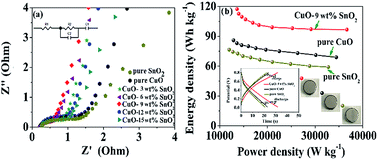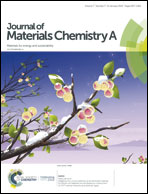CuO–SnO2 reverse cubic heterojunctions as high-performance supercapacitor electrodes†
Abstract
CuO–SnO2 reverse cubic heterojunctions are successfully synthesized by a hydrothermal reaction and a subsequent heat treatment method. CuO–SnO2 heterojunctions not only manifest a large specific capacitance of 1972 F g−1 even at 1.0 A g−1, but also fine rate properties with 1695 F g−1 at 10 A g−1 and an excellent capacitance retention of nearly 96.05% over 10 000 cycles in 6 M KOH electrolyte. In addition, the specific capacitance of CuO–SnO2 heterojunctions presents a parabolic trend with the increase of SnO2 concentration. The asymmetrical supercapacitor made from the CuO-9 wt% SnO2 heterojunction demonstrates a remarkable energy density of 117.32 W h kg−1 at a power density of 13 624.26 W kg−1. It is noteworthy that even at a high power density of 36 663.16 W kg−1, the energy density can reach 96.75 W h kg−1. The higher specific capacitance of the CuO–SnO2 heterojunctions mainly comes from their high conductivity which is improved by the high electron hole state in the heterojunctions. The excellent electrochemical properties of CuO–SnO2 heterojunctions can be attributed to their unique band structures and great conductivity, which allows efficient charge transport and electrolyte diffusion.



 Please wait while we load your content...
Please wait while we load your content...